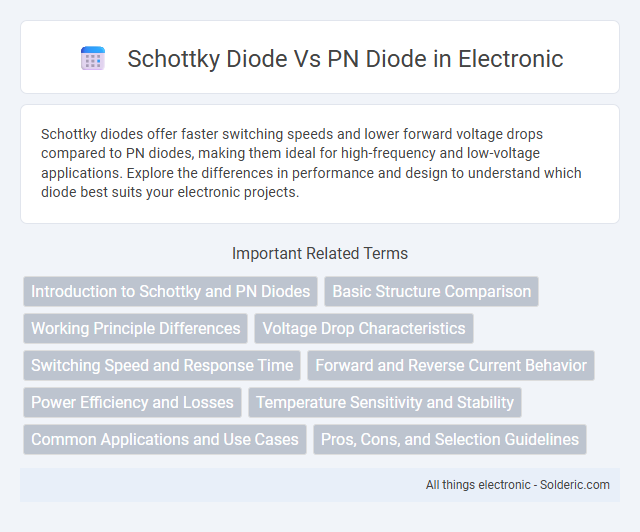Schottky diodes offer faster switching speeds and lower forward voltage drops compared to PN diodes, making them ideal for high-frequency and low-voltage applications. Explore the differences in performance and design to understand which diode best suits your electronic projects.
Comparison Table
| Feature | Schottky Diode | PN Diode |
|---|---|---|
| Junction Type | Metal-Semiconductor Junction | PN Junction |
| Forward Voltage Drop | 0.15 - 0.45 Volts (Low) | 0.6 - 0.7 Volts (Higher) |
| Switching Speed | Very Fast (nanoseconds) | Slower (microseconds) |
| Reverse Recovery Time | Minimal (Fast Recovery) | Significant (Slower Recovery) |
| Leakage Current | Higher at Reverse Bias | Lower at Reverse Bias |
| Applications | High-Speed Switching, Power Rectification, RF Circuits | General Rectification, Signal Demodulation |
| Temperature Sensitivity | More Sensitive | Less Sensitive |
Introduction to Schottky and PN Diodes
Schottky diodes, characterized by their metal-semiconductor junction, offer faster switching speeds and lower forward voltage drops compared to PN diodes, which consist of a semiconductor p-n junction. PN diodes are widely used for standard rectification and signal modulation due to their stable voltage characteristics and higher breakdown voltage. Understanding the structural differences between Schottky and PN diodes is crucial for optimizing electronic circuit performance in power supply, radio frequency, and switching applications.
Basic Structure Comparison
Schottky diodes feature a metal-semiconductor junction, typically formed by contacting a metal like platinum or gold directly to an n-type semiconductor, resulting in a low forward voltage drop and fast switching speed. In contrast, PN diodes consist of a p-type and n-type semiconductor junction, creating a depletion region that controls the diode's operation but results in a higher forward voltage drop. The Schottky diode's unique structure eliminates minority carrier charge storage, enhancing its performance in high-frequency and low-voltage applications compared to the traditional PN diode.
Working Principle Differences
Schottky diodes operate based on the metal-semiconductor junction, where the metal side forms a barrier with the n-type semiconductor, allowing for faster switching and lower forward voltage drop (typically 0.15 to 0.45V). In contrast, PN diodes rely on the p-n junction formed by p-type and n-type semiconductor materials, which results in a higher forward voltage drop (around 0.7V for silicon) and slower switching speed due to charge carrier recombination. The absence of minority carrier charge storage in Schottky diodes enables their superior high-frequency performance compared to PN junction diodes.
Voltage Drop Characteristics
Schottky diodes exhibit a lower forward voltage drop, typically ranging between 0.2 to 0.3 volts, compared to PN diodes which usually have a forward voltage drop of about 0.7 volts. This lower voltage drop in Schottky diodes results in higher efficiency and reduced power loss, making them ideal for high-speed switching and low-voltage applications. Your choice of diode significantly impacts circuit performance, especially in power-sensitive designs where minimizing voltage drop is crucial.
Switching Speed and Response Time
Schottky diodes exhibit significantly faster switching speeds and lower response times compared to PN diodes due to their metal-semiconductor junction, which minimizes charge storage. This enables Schottky diodes to operate efficiently in high-frequency applications, often switching in the nanosecond range, whereas PN diodes generally switch in microseconds. The reduced forward voltage drop and ultra-fast recovery make Schottky diodes ideal for power rectification and RF circuits where rapid response is critical.
Forward and Reverse Current Behavior
Schottky diodes exhibit lower forward voltage drop, typically around 0.2 to 0.3 volts, enabling higher forward current efficiency compared to PN diodes, which usually have a forward voltage drop of about 0.7 volts. In reverse bias conditions, Schottky diodes show higher leakage current due to their metal-semiconductor junction, whereas PN diodes have significantly lower reverse saturation current owing to their p-n junction structure. The fast switching capability of Schottky diodes arises from minimal charge storage, contrasting with slower recovery times in PN diodes caused by minority carrier recombination.
Power Efficiency and Losses
Schottky diodes exhibit lower forward voltage drop, typically around 0.2 to 0.3 volts, compared to PN diodes that range from 0.6 to 0.7 volts, resulting in higher power efficiency and reduced conduction losses in high-frequency applications. Their faster switching speed and minimal charge storage significantly decrease switching losses, making them ideal for power circuits where energy savings are critical. Your electronic designs can benefit from these efficiency gains by choosing Schottky diodes to reduce heat dissipation and improve overall system performance.
Temperature Sensitivity and Stability
Schottky diodes exhibit lower forward voltage drop and faster switching speeds but are more sensitive to temperature variations, which can affect their leakage current and overall stability. PN diodes demonstrate higher temperature stability with reduced leakage current, making them reliable for applications requiring consistent performance under varying thermal conditions. Your choice between these diodes should consider the operating temperature range and the impact on device efficiency and longevity.
Common Applications and Use Cases
Schottky diodes are commonly used in high-speed switching applications, power rectification, and voltage clamping due to their low forward voltage drop and fast recovery time, making them ideal for power supplies, RF circuits, and solar cell systems. PN diodes find widespread use in general purpose rectification, signal demodulation, and voltage regulation where higher forward voltage and slower switching speed are acceptable, such as in power adapters and signal processing circuits. The choice between Schottky and PN diodes depends on the need for efficiency, switching speed, and operating voltage in specific electronic applications.
Pros, Cons, and Selection Guidelines
Schottky diodes offer faster switching speeds and lower forward voltage drop compared to PN diodes, making them ideal for high-frequency applications and power efficiency. However, they have lower reverse voltage ratings and higher leakage currents, which limit their use in high-voltage or high-temperature environments. When selecting your diode, prioritize Schottky for low-voltage, high-speed circuits and choose PN diodes for better voltage endurance and robustness in demanding conditions.
Schottky Diode vs PN Diode Infographic

 solderic.com
solderic.com